WELCOME TO TEACHING AP HUMAN GEOGRAPHY.
Congratulations on embarking on the exciting journey of teaching APHG! Remember, you're not alone in this. NCGE proudly stands by your side, offering this kit to ensure a smooth start. Together, we'll make your teaching experience enriching and fulfilling!
Getting Started
This toolkit is packed with insights and advice from seasoned APHG educators and consultants, these resources are tailored to guide you effectively. As you embark on this teaching journey, diving deep into the curriculum and enhancing your own understanding will be invaluable.
Remember, as with teaching any new course, it is most important to familiarize yourself with the curriculum and increase your own knowledge of the topic.
College Board Course and Exam Description
The College Board Course Exam and Description (CED) is the curriculum for the course. This document is to be used for planning purposes. While it is organized with a topic, learning objectives and essential knowledge for each topic it is important to understand how the topics connect, repeat, and support each other.
The course is taught across seven units:
- Unit 1: Introduction to Geography or Patterns and Processes
- Unit 2: Population and Migration
- Unit 3: Culture
- Unit 4: Political Patterns and Processes
- Unit 5: Agriculture and Rural Land-use
- Unit 6: Urban Geography
- Unit 7: Industrial and Economic Geography
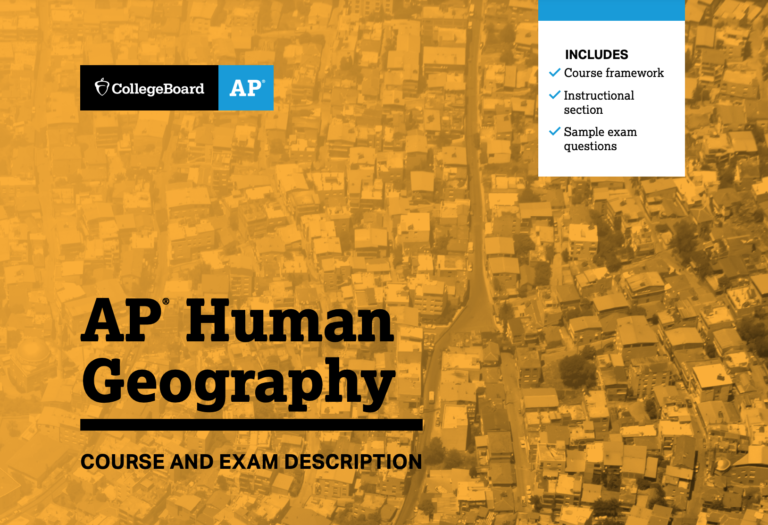
CED Available Here
None of these units should be taught in isolation but you should strive to emphasize the connections between them. The CED was created to be taught in the order as presented as the support materials created by the College Board follow this order. College Board has provided pacing recommendations with each unit.There is more about creating a year-long calendar in the Planning section found below.
Both electronic and a print copy will be helpful. The PDF has hyperlinks to resources on AP Central. With a print copy you can take notes of resources and examples to assist with your teaching.
Using the AP Human Geography CED
As a new instructor of the course, you need to review and learn the content of the curriculum. In that review, there are many new terms and concepts that need to be identified by you that you and your students will need to learn. Using the CED to create a vocabulary concept list for each unit is a very effective activity for you to identify what the students will need to know. If a term, concept, or idea is mentioned in the CED, then it is testable on the AP exam.
College Board Course Audit and AP Classroom
The College Board requires all schools and teachers that offer AP Courses to complete a course audit. In completing the course audit 1) you will agree to a number of conditions (be sure to read them); 2) you will identify the text you will use in class and 3) you will agree to use the CED as your guide in teaching the course. In turn, once your audit is complete, you will be granted access to AP Classroom. Through AP Classroom, students will gain access to resources credit by College Board to use throughout the course and for review.
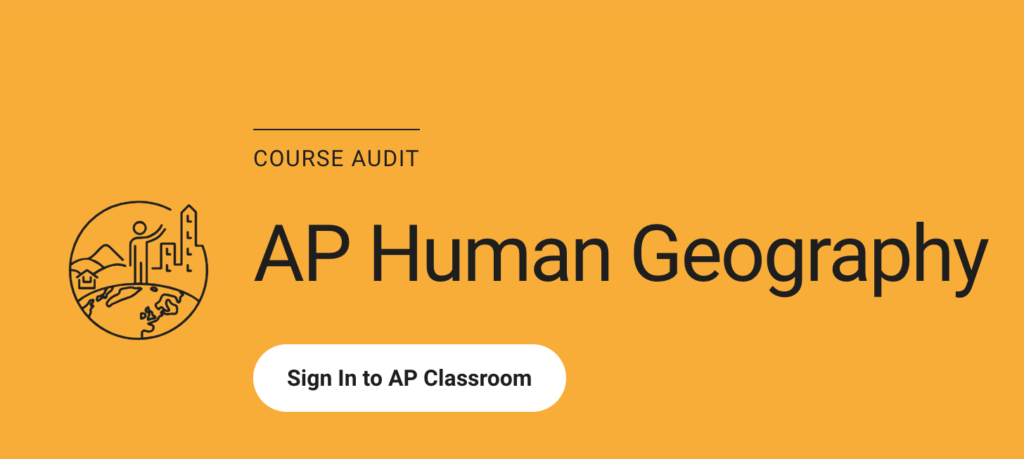
Course Audit Info Here
If you are brand new to teaching any College Board course, you will need to create an account with the College Board. Once you have this account, you will proceed to the course audit. In this audit process, you will be asked to agree to a number of terms and conditions, asked to identify the text you will be using and agree to use the Unit Guides in your class. (YES, choose the Unit Guides, you do not need to write your own syllabus to submit!) The Unit Guides ARE the CED! In selecting the Unit Guides, it will prompt you to download the CED before you are able to submit the audit. When you have submitted your Course Audit, let your school AP administrator know so that they can complete what is needed on their end and your end.
Audit Approval Next Steps
Once your Audit is complete and approved, you will be granted access to AP Classroom. Every school manages this differently, however, there is an option to create different sections for the classes you teach. You can also add teachers within your building as co-teachers so you can create resources together. If you have questions, take to your department and/or AP Administrator for assistance that is specific to your school.
When the sections are created, a JOIN code will be generated. This is the code the students need to join the course and have access to the resources you set up for them in AP Classroom. If your students are brand new to AP, they will also need to create an account. This account will stay with them throughout their academic career with College Board. Make sure they have saved their log-ins and passwords somewhere accessible! If students already have an account, they need to log into AP Classroom and use the code for your class to join your class. Talk to your department and/or AP Administration about the best plan for students creating the accounts, especially if they are 9th graders. This can be time-consuming.
Contact those at your school who have experience with using AP Classroom. Fellow AP teachers, Department Chairs, and/or your AP Administrator will be able to help you get set up and provide information about the procedures in your school.
It is strongly recommended that you spend some time getting to know the possibilities in AP Classroom. There are many resources available to you and your students.
Using AP Classroom
AP Classroom is a resource and tool from College Board. There are resources to use in your classroom such as AP Daily videos with Topic Questions (maximum of three per topic), content videos that provide case studies to use for personal learning and/or in the classroom, a database to create formative and summative assessments.
Assessment can be taken online or downloaded to use in the classroom setting. There are many features of AP Classroom so it is strongly suggested you take time to become familiar with the different features.
AP Classroom itself has specific tutorials that are very helpful. In addition to the AP Educators YouTube Channel

Student College Board Accounts and Access to AP Classroom
Students who are brand new to the AP program will need to create College Board accounts. These accounts will stay with them throughout their academic careers and College Board programs. Students who have previously had an AP class need to log in to their accounts.
Once the student has created an account, they will be able to join the course you created in AP Classroom. You will provide a join code for them to use. Once they have joined the course, they will have access to the resources you assign and/or make available to them.
*As a reminder, every student taking the course needs to have an account in order to access the materials in AP Classroom.
Talk to your department chairs and/or AP Admin about setting up AP Classroom. Here is where students also indicate if they will take the exam; there are some important deadlines in the fall.
- If you are teaching the course in a semester, again, talk to your AP Admin as there are still deadlines but they are a little different.
Learning Objectives and Course Expectations
Just like every other course, learning objectives and course expectations need to be introduced early and reiterated often. Depending on the level of student in the course, some skills may need to be taught in order to help them reach those objectives and expectations.
In the CED, you will find the THREE BIG IDEAS (p. 15). Use these throughout the course to check for understanding. Each unit has prompts that can be used to help make connections to these learning objectives.
Course expectations are going to be different for everyone as these are what set your procedures and expectations in class and out. Explain your homework policy and what the expectation is. If you are new to AP, this would be a great conversation to have with other AP teachers in your school or district.
Supporting Materials and Resources
NCGE Bellringers
APHG Bell Ringers is a set of daily questions for APHG teachers to use in their classrooms, focusing on the essential concepts of each weekly unit throughout the school year for the length of the course. Written by Laura Kmetz, these questions will help focus your students on the essential concepts of each unit. Additionally, all past Bellringers are available to members in the NCGE Resource Library.
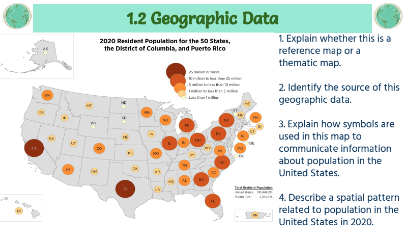
Bellringers Access
Webinars
NCGE members have access to year-long live professional development series. All webinars are archived and made available with an on-demand streaming option. Webinars include pedagogy, content, NCGE partner resources and more.
Full Webinar Schedule Here

Journals
NCGE publishes two print publications. As a member, you will receive both of the publications in print and have full access to the archive of The Journal of Geography and The Geography Teacher. The Journal of Geography publishes research, instructional approaches and book reviews on innovative approaches to geography research, teaching, and learning. The Geography Teacher publishes research on new geography teaching strategies and essential content for K-12, AP Human Geography and introductory college geography.
Access to webinars and journals is available once you have logged into your NCGE account. Links can be found on your account page.
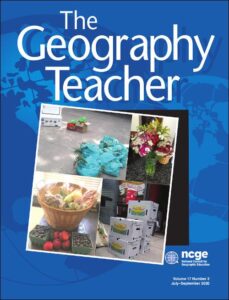
Textbooks
A list of textbooks that meet the curriculum requirements can be found on AP Central. College Board does not endorse nor recommend any one specific text.
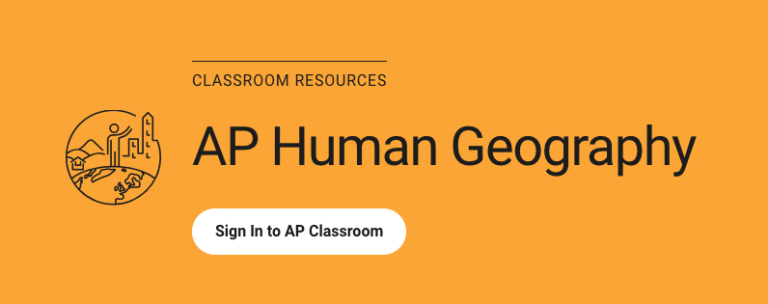
Planning your Schedule
As you are familiarizing yourself with the CED, you are probably also working on a rough draft of a year plan. If not, you definitely need to sketch something out. Get a copy of a blank school year calendar (can be found online in many formats), get a copy of your school/district’s school year calendar and the CED. Sit down and plan out the unit. The CED recommends days for each unit. This is just a recommendation based on 45 – 50 minute classes.
From the date of the exam, work backwards and around vacations. Block out the number of days you will plan for each unit. Be sure to plan in a few review days before the exam but not too much time! This year-long plan will provide guidance for you throughout the year to help you successfully teach the full curriculum before the exam.
If you are teaching on a semester or other schedule in which you don’t have a full school year, then you just need to adjust the suggested times. For example, a semester would mean you have half the days a full-year schedule does.
History Background for Students
Depending on the curriculum sequence and grade level in your district/school, you may need to fill in some gaps of history to make sense of some concepts:
- Industrial Revolution
- Imperialism/Colonialism
- Cold War
- Globalization
The Exam
The AP Human Geography exam consists of two parts: multiple choice and free-response questions. Each part is scored as 50% of the overall exam score. Refer to the above link to read more specific information about the exam. Each unit is weighted differently on the exam. Additionally, the course contains a set of skills (p 14 of the CED) that are tested.

Multiple choice strategies need to be taught throughout the year. Using AP Classroom to create assessments aligned to the CED will expose the students to questions styles similar to what they will see on the exam. Students will respond to 60 questions in 60 minutes.
Free-Response Question strategies can be taught through the teaching of writing. Each of the three FRQs have 7 parts. The first FRQ will not have a stimulus, the second will have one stimulus and the third will have two stimuli. FRQs are scored using an established scoring guide.
FRQs are written in the form of statement prompts using one of FIVE task verbs specific to this course. (from CED p159 in the print edition)
Overall Skills and Knowledge
The spatial perspective and spatial thinking is unique to the study of geography and has to be taught to the students in order for them to understand and better be able to organize, describe, explain and analyze information.
There are a lot of great resources for you to use to learn what this is and how to teach it to your students as a TOOL for thinking geographically.
Thinking Geographically Resources
- The People’s Guide to Spatial Thinking – this short read introduces what spatial thinking is and how it is already a part of our daily lives. With specific examples and applications, it will help a new teacher how to use this tool in the classroom.
- Geography for Life, National Geography Standards – this document explains why ‘the geographic lens enables students to acquire and use spatial and ecological perspectives to develop an informed world.’ (p13, Geography for Life; NCGE)
- Teaching Geography by Phil Gersheml ISBN 978-1462516414 – a comprehensive resource that explains basic geographic principles and demonstrates effectives ways to promote student spatial thinking skills.
- From our Partner ESRI – Developing Spatial Thinking Skills in Education and Society By Joseph J. Kerski, Ph.D., Education Industry Curriculum Development Manager, Esri
- Available thru the archive access to The Geography Teacher
- Injeong Jo, Sarah Bednarz & Sandra Metoyer (2010) Selecting and Designing Questions to Facilitate Spatial Thinking, The Geography Teacher, 7:2, 49-55, DOI: 10.1080/19338341.2010.510779
- Mark C. Jones (2016) To Think Spatially and Environmentally, Put on Your Geography Sunglasses!, The Geography Teacher, 13:2, 79-81, DOI: 10.1080/19338341.2016.1175365
- NCGE Webinars –
- Teaching Students to Think Spatially with Dr. Injeong Jo Aug 31, 2022
- Making Geographic Thinking Stick with Dr. Erin Fouberg and Dr. Janet Smith Dec 4 2021
- Geographic Perspective by National Geographic:

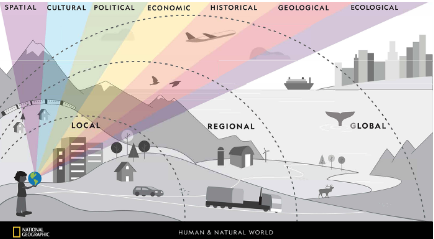
Strategies and Skills for Students to be Successful
- Teach students different note-taking strategies and HOW to read a textbook. Get them to think critically about the text and to use it as a learning tool.
- Teach students strategies to approach geographic thinking like ESPN or SPEED.
Economic
Social
Political
eNvironmental
Social
Political
Economic
Demographic
3. Students need to understand how the concepts relate to real-world examples
Here is a great resource that introduces both ESPN and SPEED. This resource will help students to use the elements to process/apply information in various formats such as short answers responses, tickets out the door, setting up writing samples for AP Human Geography and other courses involving the study of geographic concepts. Students can use these ‘hooks’ in their study of geography, can be applied in every unit where these skills are needed and helps further critical thinking skills.
Resource Library
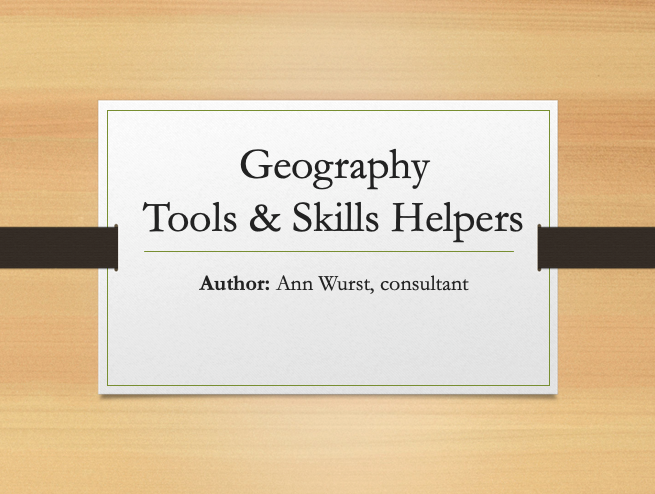
Vocabulary and Course Concepts
Vocabulary is a key component to the study of Human Geography, as many terms and concepts are new to students. Teachers need to determine what works best for their students regarding vocabulary. There are a variety of techniques and strategies that teachers use…flashcards, charts, definitions, hexagonal thinking, Quizlet, Word Wall etc. Teachers need to use the vocabulary and model examples of application with the students in class. Vocabulary is a vital aspect of this course and it needs to be worked with on a daily basis. Students need to use vocabulary terms and work with them in class to describe the patterns, distributions, etc. they see in the data being presented.
Accessing resources in your communities
Your communities have many resources that you can tap into:
- Community College or College University departments for speakers
- City Planning departments;
- Agricultural departments; local farms; grocery stores
- Religious organization
- Drone technology
- Parents who use geography in their jobs
- ZOOM in guest speakers
Increase YOUR knowledge of Geography and AP Human Geography
- Understand the structure of the exam in order to teach the skills and objectives of the course
- Acquire copies of multiple resources like textbooks (list of text that meet the expectations of the course HERE) and review books (like Kaplan, Princeton, Barrons, iScore, AMSCO etc.) to use for your knowledge of geography and to access assessment items to use in the course.
- Have that toolkit of differentiation strategies out and open
- Follow social media sites for pedagogy and content ideas
- Join the AP Human Geography Teachers Page on Facebook
- AP Community Discussion Group
- Sign up for regular emails that can provide you content ideas
- AGS Daily Geo
- Watch AP Daily videos in AP Classroom
- Advanced Placement YouTube Channel
- Use the teaching pedagogy and learning strategies you know.
- Utilize a variety of on-line tools and strategies for delivering the content such as: EdPuzzle, TedEd videos, NearPod, Peardeck, Kahoot, Quizizz, Perusall, etc. Check with your department, school or district to see if there are licenses.
- Review lessons and activities you find online; edit them to make them your own and reflect your students’ situations.
- Create and write your own lessons. This is the BEST way to learn the content.
- Use resources from our partners
- Population Connection
- Census Bureau
- ESRI – ArcGIS, Storymaps, GeoInquiries and so much more
- ArcGIS has a full version available to schools for free. You will have to research a little to find out what your district has access to.
- State Geographic organizations (often known as Geographic Alliances)
- National Agriculture in the Classroom
- National Geographic and ESRI launched a new Mapmaker application
In Conclusion...Remember
Embarking on the journey of teaching AP Human Geography is both an honor and a responsibility, and it’s understandable to feel both excitement and apprehension. But remember, you are not alone on this path. With the APHG Starter Kit by your side, backed by the collective wisdom of seasoned APHG educators and consultants, you have a solid foundation to build upon. NCGE believes in your capability and potential, and with this kit, we aim to empower you every step of the way. Welcome to the enriching world of AP Human Geography teaching; together, we will inspire the next generation to understand and appreciate the intricate tapestry of our shared human experience. Dive in with confidence and passion!
